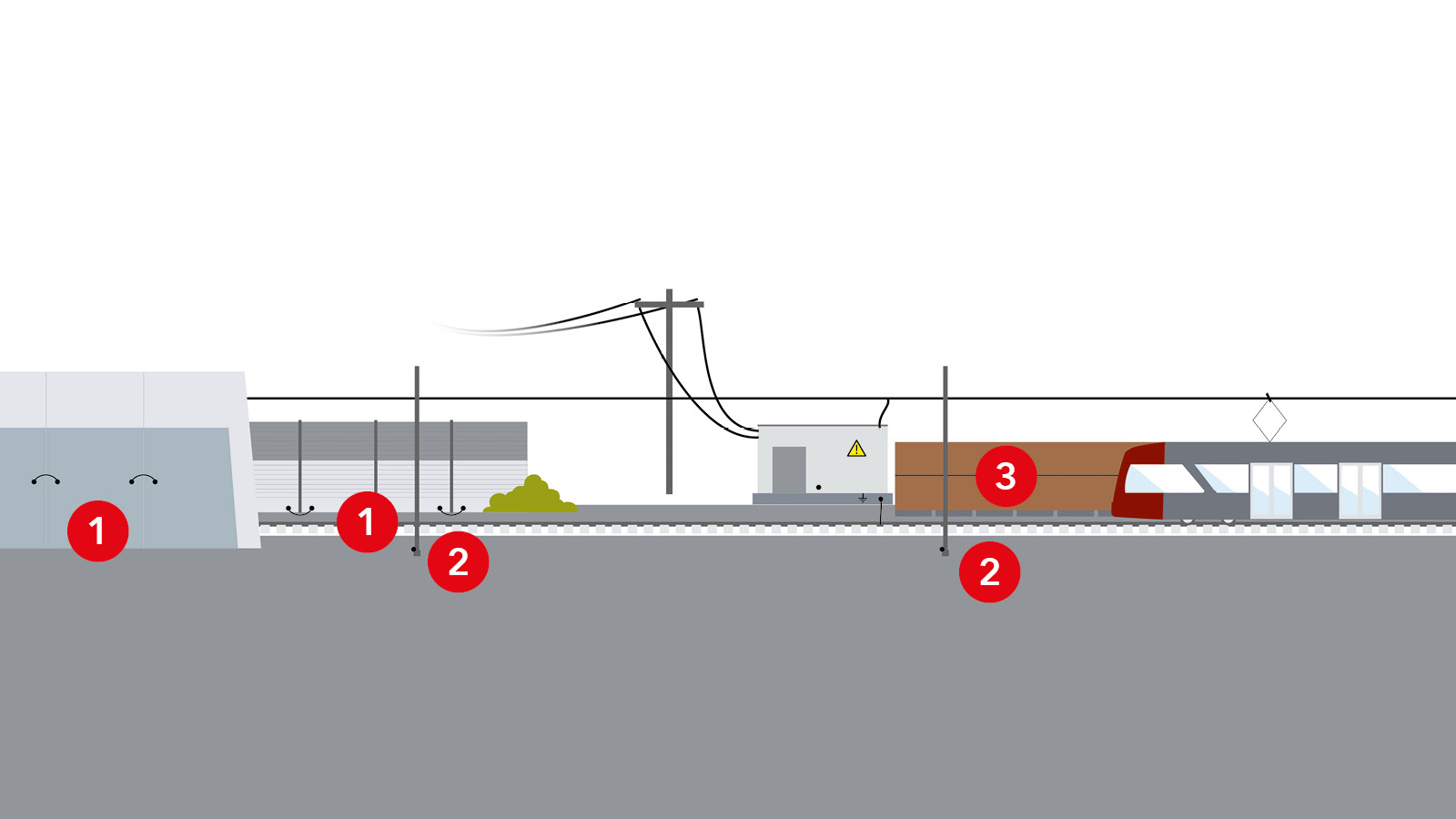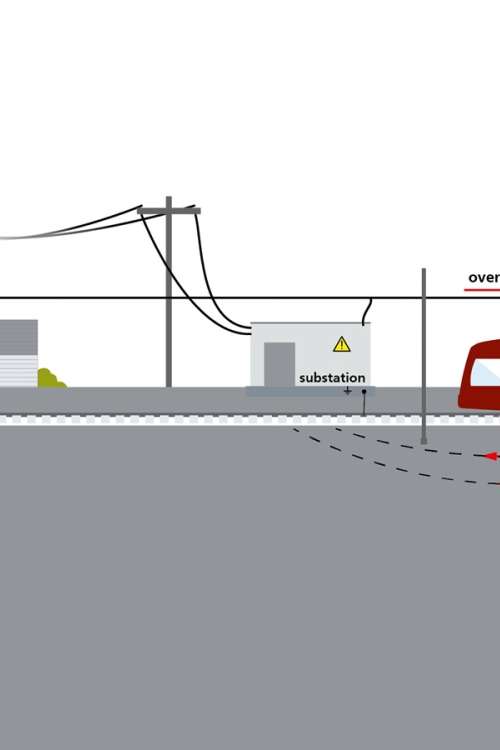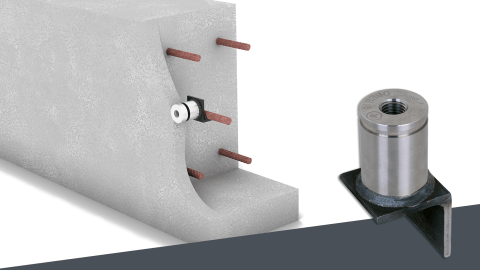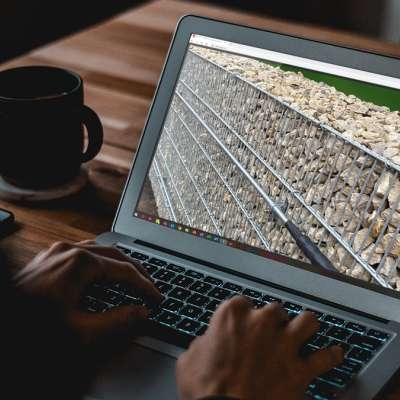Railway earthing
Railway earthing and return circuits are essential to safeguard railway operations and protect people.
They ensure that in the event of damage – such as a contact wire break – no dangerous voltages are transmitted to people or equipment and that the power supply is safely switched off.
DEHN offers full range of components, earthing bridges and earthing connectors for railway earthing equipment and building earthing.

Solutions for railway earthing
Railway earthing comprises the short-circuit current-proof connection of all conductive components, the return circuit and the entire earthing at the substation. These include catenary masts, tracks, steel and reinforced concrete bridges, tunnel systems, conductive components on platforms, noise barriers, boundaries and railings as well as earthing systems for power supply and telecommunications installations.
With DEHN's extensive range of earthing components, you can protect the infrastructure for railway operations and people in the railway environment.
/de.hn/store/f/59701484/HDVORSCHAU/419040.jpg)
419041
Copper cable earthing bridge
Copper cable earthing bridge according to the guideline of DB Netz AG Ril 997.0205A01, for earthing, current return circuits and equipotential bonding in railway line applications.
/de.hn/store/f/59701583/HDVORSCHAU/419290.jpg)
419291
Steel rope earthing connector
Copper-steel-aluminium cable earthing connector as per guideline of DB Netz AG Ril 997.0205A01, for earthing, return circuits and equipotential bonding in railway applications.
/de.hn/store/f/59701579/HDVORSCHAU/419290.jpg)
419290
Cable earthing connector
Copper-steel-aluminium cable earthing connector as per the guideline of DB Netz AG Ril 997.0205A01, for earthing, return cicuits and equipotential bonding in railway line application.
/de.hn/store/f/59701433/HDVORSCHAU/419010_1.jpg)
419010
Flat steel earthing bridge
Flat steel earthing bridge according to the guideline of DB Netz AG Ril 997.0205A01, for eathing, return current circuits as well as equipotential bonding in railway line applications.
/de.hn/store/f/59701426/HDVORSCHAU/419160.jpg)
419160
Stainless steel earthing bridge
Stainless steel earthing bridge according to the guideline of DB Netz AG Ril 997.0205A01, for earthing, current return circuits and equipotential bonding in railway line applications.
/de.hn/store/f/59701555/HDVORSCHAU/419110.jpg)
419110
Earthing bridge
Earthing connector for earthing large pipes according to the guideline of DB Netz AG Ril 997.0205A01, for earthing, return current circuits as well as equipotential bonding in railway line applications.
/de.hn/store/f/59701565/HDVORSCHAU/419400.jpg)
419400
Earthing connector
Earthing bridge for earthing large pipes as per the guideline of DB Netz AG Ril 997.0205A01, for earthing, retun circuits and equipotential bonding in railway line applications.
/de.hn/store/f/59701405/HDVORSCHAU/419000.jpg)
419000
Stainless steel earthing bridge
Stainless steel earthing bridge according to the guideline of DB Netz AG Ril 997.0205A01, for earthing, current return circuits and equipotential bonding in railway line applications.
/de.hn/store/f/59626383/HDVORSCHAU/419761.jpg)
419761
Press connector
Press connector made of aluminium for connecting two Ø16‑mm short-circuit wires.
/de.hn/store/f/59626387/HDVORSCHAU/419763.jpg)
419763
Press connector
Press connector made of aluminium for connecting a 100/110 mm2 railway earthing cable with a Ø16 mm short-circuit wire.
/de.hn/store/f/59626376/HDVORSCHAU/419750.jpg)
419750
Conductor holder
Angle bracket made of HDG steel for fixing short-circuit wire Rd 10–16 mm to gabion walls and steel grid fences Rd 4–8 mm. Attached with DEHNquick saddle clamp.
/de.hn/store/f/57092592/HDVORSCHAU/275260.jpg)
275260
Rod holder
Rod holder with slotted saddle clamp and flange, for fixing air-termination and earth entry rods Rd 16 mm, fixed conductor routing, pre-assembled with screw and plug.
Basics of railway earthing: Railway earthing und return circuit
To protect people and systems in the event of an overhead contact line break, all electrically conductive parts must be connected directly or indirectly to the running rails. The basis for the railway earthing is the traction system earth. The running rails are the central components in this respect: they are directly connected to the surrounding ground, are therefore earthed and perform the task of returning the current. They conduct the current from the overhead contact line back to the substation. All connections between conductive system components in the break area of the overhead contact line and the running rails must be designed to withstand short-circuit currents. This means that earthing bridges and earthing connectors must be able to withstand the maximum current that occurs.

Railway earthing at a glance:
1) The operating current flows from the substation via the overhead contact line to the traction unit and supplies it with energy.
2) The current flows back to the substation via the return circuit (running rail). The running rails form the traction system earth: conductive and earthed, they are used to return the traction current (return circuit).
Short-circuit-current resistance
All connections between conductive system components and the running rails must be designed to withstand the maximum short-circuit currents.

Earthing bridges for noise barriers
D BEB 16 – the all-rounder among railway earthing components with high stability and easy installation. The earthing bridge consists of a stainless steel cylinder and a welded-on steel bracket. The round design prevents components from being attached in a lopsided fashion.
To the productSeminars

Railway earthing
Find out more about the importance of railway earthing and how measures are implemented in practice in compliance with standards.

Short-circuit wire
Learn specific examples of the use of short-circuit wires for railway earthing.
Downloads
| Brochure | DEHN railway earthing | Expert solutions | .pdf 2 MB |
| Brochure | Railway infrastructure | DEHN protects the railway infrastructure | .pdf 5.3 MB |
Any questions about protection solutions for railway infrastructure?
Contact our experts at itss@dehn.de.
Or find your contact person here – worldwide.
/de.hn/store/f/59626360/HDVORSCHAU/483200.jpg)